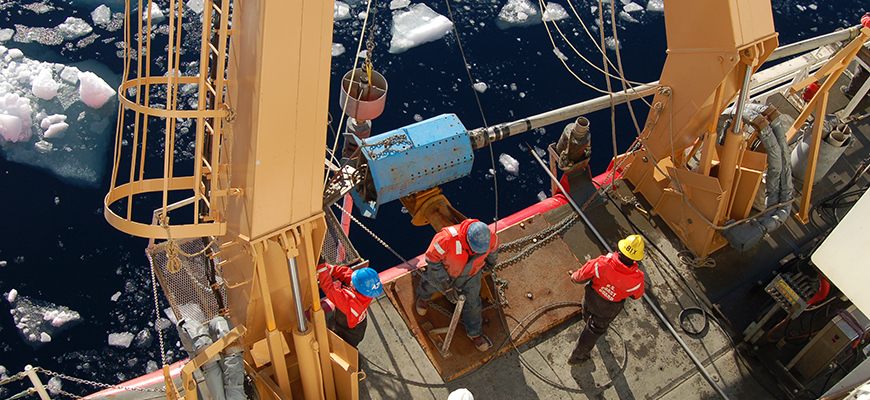Global S&T Development Trend Analysis Platform of Resources and Environment
| Research Highlight: Evidence of Ancient Abrupt Climate Change Found in Arctic | |
| admin | |
| 2018-07-09 | |
| 发布年 | 2018 |
| 语种 | 英语 |
| 国家 | 美国 |
| 领域 | 资源环境 |
| 正文(英文) |  Researchers gather sediment cores from Beaufort Sea during 2013 fieldwork. Photo: Lloyd Keigwin/WHOI A team of researchers from Scripps Institution of Oceanography at the University of California San Diego and Woods Hole Oceanographic Institution found evidence for a massive flood of fresh water in the western Arctic, thought to be the cause of an ancient cold snap that began around 13,000 years ago.
The find could put to rest a question that has been open among scientists for more than 100 years. The existence of the cold snap, called the Younger Dryas, had been known for decades but the physical cause for its origin had eluded researchers who traveled to points throughout the Atlantic Ocean, the eastern United States, and Canada looking for it.
In 2013, Scripps geologist Neal Driscoll, Woods Hole oceanographer Lloyd Keigwin and colleagues set sail to the eastern Beaufort Sea in search of evidence for the flood offshore of the Mackenzie River, which forms the border between Canada’s Yukon and Northwest territories. From aboard the U.S. Coast Guard Cutter Healy, the team gathered sediment cores bearing fossils of microscopic organisms known as foraminifera from along the continental slope north of the Mackenzie River.
The researchers found a record of the event encased in seafloor sediment over 200 kilometers (~135 miles) from the mouth of the river. Preserved in the shells of foraminifera were isotopes of oxygen with a ratio that is consistent with a large incursion of glacially derived freshwater.
“The signature of oxygen isotopes recorded in foraminifera shells preserved in the sediment allowed us to fingerprint the source of the glacial lake discharge down the Mackenzie River 13,000 years ago,” said Driscoll, a co-author author of the National Science Foundation-funded study. “Radiocarbon dating on the shells provided the age constraints. How exciting when the pieces of a more than 100-year puzzle come together."
The abrupt climate change triggered by the freshwater inundation ended more than 2,000 years of warming, said Keigwin, an oceanographer at WHOI and lead author of the study, which appears online July 9 in the journal Nature Geoscience.
The Younger Dryas triggered dramatic changes to regional climates. The freshwater from glaciers made its way from the Arctic to the north Atlantic Ocean. There it disrupted a circulation pattern that stretches from Greenland to the Southern Ocean. That pattern, the Atlantic Meridional Overturning Circulation (AMOC), transports warm equatorial waters poleward and releases heat to the atmosphere.
That disruption caused substantial cooling in Europe, The Younger Dryas in fact takes its name from a flower (Dryas octopetala) that flourished in the continent’s cold conditions at the time.
The Younger Dryas lasted a mere 200 years making it only a short blip in a warming period that has lasted 20,000 years but to scientists like Driscoll, it’s an important example of how feedbacks affect the climate system. Overall trends of warming or cooling on Earth are not linear but are punctuated by reversals and accelerations such as this one. Such events help scientists interpret current trends, distinguishing global climate signals from regional signals.
Next steps in future research, Keigwin said, will be for scientists to answer remaining questions about the quantity of fresh water delivered to the North Atlantic preceding the Younger Dryas event and over how long of a period of time.
"Events like this are really important, and we have to understand them better," adds Keigwin. "In the long run, I think the findings from this paper will stimulate more research on how much fresh water is really necessary to cause a change in the system and weakening of the AMOC. It certainly calls further attention to the warming we're seeing in the Arctic today, and the accelerated melting of Greenland ice."
Earlier this year, a paper by researchers at the University College London and WHOI found evidence that the AMOC hasn’t been running at peak strength since the mid-1800s and is currently at its weakest point in the past 1,600 years. Continued weakening could disrupt weather patterns from the U.S. and Europe to the African Sahel.
Besides Keigwin and Driscoll, co-authors of the paper include Ning Zhao and Liviu Giosan of WHOI, Shannon Klotsko of Scripps Oceanography, and Brendan Reilly of Oregon State University.
|
| URL | 查看原文 |
| 来源平台 | Scripps Institution of Oceanography |
| 文献类型 | 新闻 |
| 条目标识符 | http://119.78.100.173/C666/handle/2XK7JSWQ/107385 |
| 专题 | 资源环境科学 |
| 推荐引用方式 GB/T 7714 | admin. Research Highlight: Evidence of Ancient Abrupt Climate Change Found in Arctic. 2018. |
| 条目包含的文件 | 条目无相关文件。 | |||||
| 个性服务 |
| 推荐该条目 |
| 保存到收藏夹 |
| 查看访问统计 |
| 导出为Endnote文件 |
| 谷歌学术 |
| 谷歌学术中相似的文章 |
| [admin]的文章 |
| 百度学术 |
| 百度学术中相似的文章 |
| [admin]的文章 |
| 必应学术 |
| 必应学术中相似的文章 |
| [admin]的文章 |
| 相关权益政策 |
| 暂无数据 |
| 收藏/分享 |
除非特别说明,本系统中所有内容都受版权保护,并保留所有权利。
修改评论